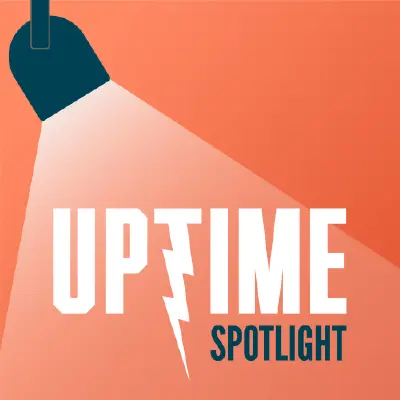June 26, 2025 · 18 min
Antoine Larvol, CTO of Windar Photonics, discusses how their continuous wave LiDAR technology enhances wind turbine performance through optimization and monitoring, increasing AEP and reducing loads, particularly for legacy turbines.
Sign up now for Uptime Tech News, our weekly email update on all things wind technology. This episode is sponsored by Weather Guard Lightning Tech. Learn more about Weather Guard's StrikeTape Wind Turbine LPS retrofit. Follow the show on Facebook, YouTube, Twitter, Linkedin and visit Weather Guard on the web. And subscribe to Rosemary Barnes' YouTube channel here. Have a question we can answer on the show? Email us!
Welcome to Uptime Spotlight, shining light on wind. Energy's brightest innovators. This is the Progress Powering Tomorrow.
Alright, we're here in Phoenix, a CP, clean power, uh, 2025. So I'm, uh. Sitting with Antoine Larvol from, he's a CTO from Windar. Yep. Welcome to the show. Thank you. Uh, we've been, uh, happy enough to get actually to sit inside your booth where it's nice and qui. Quiet and isn't it nice? Yeah. We got glass behind the camera here and people are walking by, walking by, walking by.
Um, so this morning, uh, we, we talked yesterday a little bit about what wind photonics does. Yep. Of course, from our, uh, some of our other friends around the world. We've heard about some, some campaigns you've done in the United States, which have been. Really successful. So yeah, congrat good. Congratulations there.
Yeah, thank you. Um, and, and as, as a lot of things in the wind industry, Windar, photonics based in Denmark.
Antoine Larvol: Yeah.
Joel Saxum: So you guys, uh, bring it, bring in that Danish [00:01:00]technology. We're here, of course, bringing it to the US market at a CP, the American Clean Power Show. So welcome to the States. Thank you. Um, it's a short one, but a
Antoine Larvol: good one.
Yeah, yeah, yeah,
Joel Saxum: exactly. So, so I want to talk a little bit about what Windar photonics and, and it is a LIDAR based sensor, correct?
Antoine Larvol: Yes. Right. So. We do continuous wave base, uh, lidar. Yep. Uh, main product is a two beam version mm-hmm. Where you shoot, uh, at 80 meters in front of the turbine. Mm-hmm. And you basically alternate from one beam to the other.
And measure wind speed and direction upfront, the, the turbine among others.
Joel Saxum: Right. So we're talking about, uh, if you, if you're in the wind industry, you've ever seen these lidar units that are put actually, you're the cell mounted, correct? Yes. Okay. Yeah. So, and, and, uh, we're looking more on the optimization, retrofit monitoring side of things.
Yeah,
Antoine Larvol: exactly. So we've never been a resource assessment company. Yeah. Or we don't look at power curve verification and stuff like that. We really [00:02:00] focus on. Retrofitting those, existing turbines. And then add value to In terms of information to, the customer, Yeah. With the mon monitoring side of things.
Yeah. And, from day one, that's been the goal of Windar Making something cheap, robust. That can just stay there and measure with good availability, wind speed, and direction coming to your turbine.
Joel Saxum: I love it. so we wanna squeeze as much as we can outta these turbines. And you guys are increasing AEP that's, the name of the game.
Yeah. Right.
Increasing AEP below rated. and then above rated you decrease loads. Increase uptime. and we basically do that by going on the line of the wind direction. that you then feed to the turbine controller and then we can actually adjust the, yaw position of the turbine according to our information.
So I want to talk a little bit, we, we chatted a little bit offline about the, technology behind it, right? Yep. And people in the wind industry, if you're around the wind industry around resourcing or you're around optimization, you've heard [00:03:00] lidar. Yep. You know what I mean? And,
